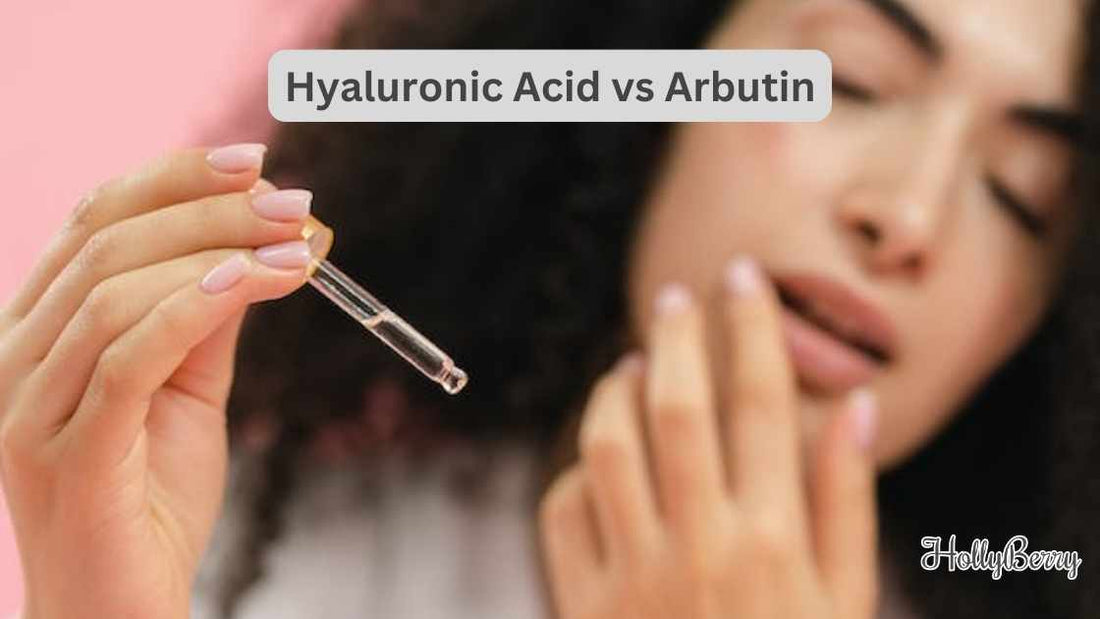
Hyaluronic Acid vs Arbutin
Share
Unveiling the Best for Skin Hydration and Brightness

Hyaluronic acid and arbutin are two ingredients often mentioned in the realm of skincare, each sought after for their distinctive benefits. Hyaluronic acid is known for its exceptional hydrating properties, making it suitable for all skin types and particularly beneficial in retaining moisture.
It operates by drawing water into the skin, thus enhancing its plumpness and reducing the appearance of fine lines and wrinkles.
As a naturally occurring substance in the human body, its compatibility with the skin is high, presenting a favourable option for those seeking to bolster their skin's hydration levels.
Arbutin, on the other hand, stands out in the skincare industry for its targeted approach to hyperpigmentation and dark spots.
Derived from bearberry plants, it functions by inhibiting tyrosinase, an enzyme responsible for melanin production. Its effectiveness in managing melanin production makes it a popular ingredient for those aiming to achieve a more even skin tone and diminish the visibility of pigmentation issues.
Both ingredients are integrated into various skincare products and routines, with cost and desired outcomes influencing an individual's choice.
While hyaluronic acid may be generally more expensive, its all-encompassing suitability for different skin types and hydration capabilities justifies the investment. Conversely, individuals with a tighter budget or specific skin concerns such as hyperpigmentation may find arbutin to be a more accessible and targeted option.
Comparative Analysis of Hyaluronic Acid and Arbutin
This section provides a detailed comparison between Hyaluronic Acid and Arbutin, focusing on their chemical properties, benefits in skincare, and potential side effects.
Chemical Properties and Derivatives
Hyaluronic Acid (HA) is a biopolymer composed of d-glucuronic acid and N-acetyl-d-glucosamine. It is renowned for its ability to retain moisture, making it a principal component in various hydrating serums and creams.
Arbutin, however, is a glucoside formed by hydroquinone and sugar. It exists as two isomers: Alpha Arbutin and Beta Arbutin. Alpha Arbutin is synthetically derived and prized in skincare for its efficacy in lightening the pigmentation without the harsh side effects often associated with hydroquinone.
Skincare Benefits and Efficacy
Hyaluronic Acid:
- Hydrating: Enhances skin's moisture content
- Anti-Aging: Assists in reducing the visibility of fine lines and wrinkles by retaining moisture
Arbutin:
- Pigment Corrector: Targets hyperpigmentation and dark spots
- Tyrosinase Inhibitor: Acts on the enzyme tyrosinase, preventing the formation of melanin
Both compounds are included in skincare routines due to their effectiveness. HA is typically found in serums and creams aimed at improving skin hydration. Arbutin is also used in serums and creams, particularly those formulated to fade dark spots and even skin tone.
Potential Side Effects and Skin Suitability
Hyaluronic Acid is widely considered safe for all skin types, particularly as it is a substance naturally present in the human body. It is unlikely to cause irritation or redness, making it ideal for individuals with sensitive skin.
In contrast, some derivatives of hydroquinone, which is related to Arbutin, can cause skin irritation.
However, Arbutin, especially the Alpha Arbutin variant, maintains a reputation for being gentler and safer than its hydroquinone counterpart. It is generally well-tolerated, but as with all active ingredients, patch testing is recommended before widespread use to avoid possible side effects like irritation or allergic reactions.
Inclusion in Skincare Routines
The incorporation of hyaluronic acid and alpha arbutin into skincare routines hinges on their distinctive properties—hyaluronic acid for hydration and alpha arbutin for improving skin tone.
Selecting the appropriate products and pairing them with synergistic ingredients can considerably enhance skincare outcomes.
Recommended Products and Usage
ORDER OUR HYALURONIC ACID FROM OUR UK SHOP
-
Hyaluronic Acid: Typically found in serums and moisturisers, it's advisable to apply products containing hyaluronic acid on damp skin to lock in moisture. A popular choice is The Ordinary Hyaluronic Acid 2% + B5.
Routine:
- Cleanse skin thoroughly.
- Apply hyaluronic acid serum while skin is still damp.
- Follow with a moisturiser.
- Finish with sunscreen during the day, SPF 30 or higher.
-
Alpha Arbutin: This ingredient is effective for fading dark spots and can be used in the form of serums, like The Ordinary Alpha Arbutin 2% + HA. It's important to perform a patch test before regular use.
Routine:
- Cleanse skin and pat dry.
- Apply alpha arbutin serum.
- Layer with a moisturiser.
- Always use sunscreen in the daytime, as alpha arbutin can make skin more sensitive to the sun.
Additional Ingredients Synergy
Hyaluronic Acid pairs well with most ingredients and is enhanced by:
- Vitamin C (Ascorbic Acid): Amplifies photoprotection effects.
- Niacinamide: Supports barrier function and hydration.
- Vitamin A (Tretinoin): For an anti-ageing regimen, tretinoin increases cell turnover, while hyaluronic acid provides hydration to mitigate irritation.
Alpha Arbutin works in concert with:
- Kojic Acid: Combinations target hyperpigmentation more effectively.
- Niacinamide: For an even skin tone and to minimise inflammation.
- Cleansers and Moisturisers: Should be non-irritating and help maintain the natural skin barrier.

